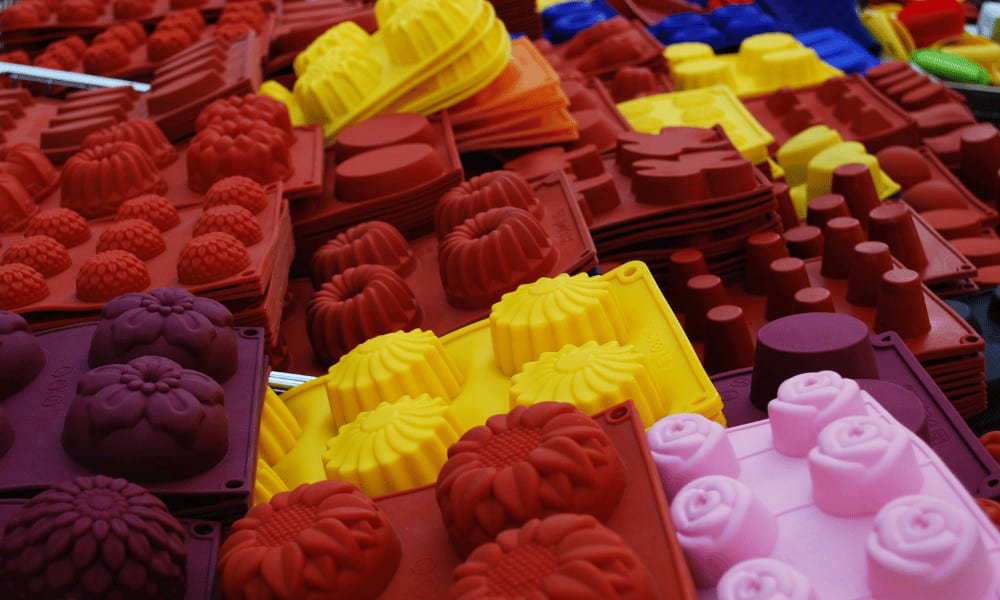Whether you are concerned that plastic might be leaching toxic chemicals into your food, or you simply want to reduce your use of single-use plastics like food storage bags, if you are looking for alternatives to plastic storage containers, silicone might be the way to go.

Can You Freeze Food In Silicone?
Silicone storage containers are widely available in a range of shapes and sizes and are suitable for use in the freezer, fridge, oven and microwave. Silicone cookware, such as baking trays and cake moulds, can also be used in the freezer.
What Is Silicone Kitchenware Made From?
Silicone is a synthetic rubber made from silicone, oxygen, carbon, and hydrogen.
It has become widely used in kitchenware in recent years, most notably for baking trays, cake moulds and kitchen utensils.
Why Is Silicone Kitchenware So Popular?
Because the material itself is translucent, it can be produced in a rainbow of bright and bold colours, which has no doubt contributed to its popularity.
The main benefit is that silicone kitchenware is lightweight and easy to store.
Silicone is non-porous, so it does not absorb smells or stains. It is easy to wash and reusable, making it a great alternative to single-use plastics. Silicone cookware is non-stick and often does not need greasing, plus it is flexible, making it much easier to remove cooked items.
Is It Safe to Freeze Food in Silicone?
Silicone is considered safe for storing food because although it is a manmade product, it is made from naturally occurring elements. There are currently no known health risks associated with using silicone cookware.
In recent years there have been some reports that chemicals such as BPA, BPS, PVC and phthalates might leach into food that is stored or cooked in plastic containers.
These chemicals have been associated with cancer, immune disorders, infertility and other health issues.
If you are concerned about the possible risks of using plastics, silicone could be a great alternative.
However, there is some evidence that some silicone can become liquid when exposed to temperatures over 220oC, so read the instructions on your silicone kitchenware carefully.
What are the Benefits of Freezing Food in Silicone?
Silicone is a great choice for food storage as it can be kept in the fridge or freezer, plus it can be used in the oven and microwave and is dishwasher safe.
It lasts much better than plastic as it does not become stained, cracked or brittle over time. It is also non-toxic and odourless.
It copes well with both high and low temperatures and sudden changes in temperature, meaning it can be used in the oven straight from the freezer. It is lightweight and easy to store, with many items being designed to be collapsed or squashed for storage.
Silicone storage containers are widely available in a range of shapes, sizes and colours. There is also an extensive range of cookware available, including roasting trays, baking trays and cake moulds in an impressive array of shapes and designs.
Silicone freezer bags are a great alternative to single-use plastic freezer bags. They are much more durable, meaning they can be washed and reused a great many times without the risk of ripping or leaking.
You can pour liquids such as soups and sauces into silicone freezer bags, carefully squeeze the air out and seal them, and then lay them flat for freezing, meaning that they take up less space in the freezer.
Silicone freezer bags can also go in the microwave, meaning you can cook them from frozen.
Silicone ice cube trays are much more user-friendly than their plastic counterpart. Unlike plastic, silicone does not become brittle when frozen. It is, therefore, great for making ice cubes as the flexibility of the tray makes the ice cubes much easier to remove from the tray.
What are the Drawbacks of Freezing Food in Silicone?
Some people complain that silicone has a rubbery smell and it can give food a rubbery taste.
If you find this is the case, soaking the item in a mixture of 50-50 water and white vinegar should eradicate the problem.
Silicone is very flexible, which has lots of advantages, but when used for cookware it can make items tricky to handle, for example, when transferring liquids to the freezer, or when placing silicone cookware in the oven.
Placing the silicone cookware on a baking tray can help with this.
Which Foods Freeze Well in Silicone?
One great use for silicone in the freezer is to use moulds to freeze liquids in small portions.
Choose a mould with sections about the size of a cupcake – baby-weaning freezer pots are great for this. You can then freeze liquids such as soups and sauces in smaller portions.
For example, rather than freezing 4 portions of soup in one solid mass that will take hours to defrost, you could spread the soup across several freezer pots, then when frozen, the flexibility of the silicone mould will allow you to easily pop the cubes out and store them in a silicone freezer bag.
Then when you want to use your soup, you have the option to defrost the whole lot, which will thaw much more easily in small chunks, or you could just defrost as much as you need for that meal.


